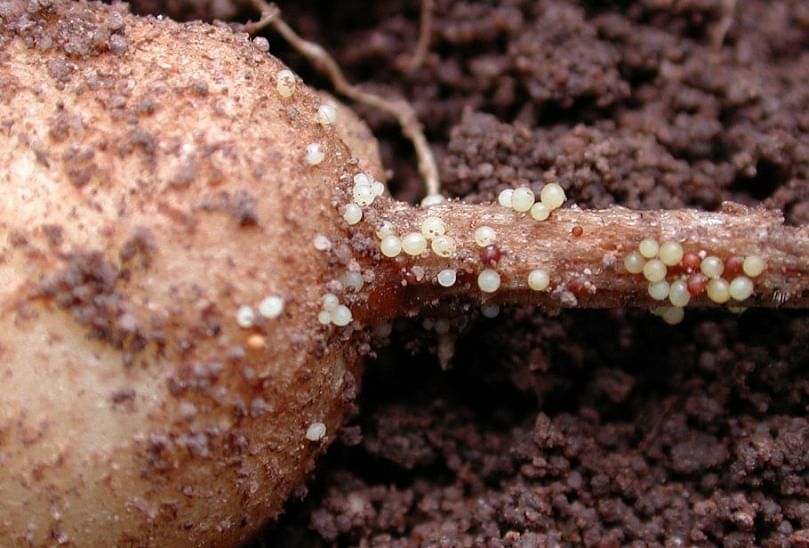Cyst on a potato root
Potato parasite’s `toolkit’ revealed

Parasitic nematode worms are the `hidden enemy’ of farmers world-wide, causing billions of pounds worth of crop damage every year.
Now an international research collaboration led by the University of Dundee and the James Hutton Institute has detailed the genome sequence and inner workings of the yellow potato cyst nematode (PCN), giving scientists new insights into how it can be stopped.
Dr Sebastian Eves-van den Akker, of the University of Dundee’s Division of Plant Sciences, based at the James Hutton Institute:
“This is an exciting discovery which reveals the potato cyst nematode’s ‘parasitism toolkit’.”The results of the research are published in the journal Genome Biology, and like all science funded by the Biotechnology and Biological Sciences Research Council, are freely available for everyone to read.
“Once we had sequenced the genome of the nematode, we uncovered a hidden genetic code, or signpost, that points towards the molecular tools the nematode uses against plants. We believe this genetic code is actually how the nematode categorises which genes it needs when infecting plants so, in a way, we can use their own signpost against them.
“Using this information we will now be able to much better target how we can prevent nematode infection.”
Potato cyst nematodes are devastating to crops and are exceptionally hardy: once established in a field, PCN are effectively impossible to eradicate in the short term, and because they persist as long-lived cysts in soils, growing potatoes may not be economically viable for up to two decades.

Potato infected by potato cyst nematodes (Courtesy: DuPont)
All major crops are thought to be infected by at least one species of plant-parasitic nematode, which cause damage valued at over $80 billion each year.
Dr Eves-van den Akker
“Nematodes are the hidden enemy to crops.”Now researchers have found the toolkit for the potato cyst nematodes, the aim is to carry out similar analyses in other nematodes. There are currently very few pesticides available which can deal with a nematode infection, as most of them have been withdrawn for various reasons. So there is a pressing need to find new ways to prevent crop infection, particularly given the increasing importance of potato as a major food staple around the world, including in China.
“Thousands of these microscopic worms can infect a single plant, and there can be several million in an infected field. Given that they live hidden in the soil and attack the root, they have a devastating impact on the rest of the plant that is hard to recognise.”
Read More:
Sebastian Eves-van den Akker et al. The genome of the yellow potato cyst nematode, Globodera rostochiensis, reveals insights into the basis of parasitism and virulence, Genome Biology (2016).DOI: 10.1186/s13059-016-0985-1
Dr Eves-van den Akker:
“If we can target these areas of the nematode’s activity then we will be better able to stop it.”The international collaboration has been led by award-winning researchers at the University of Dundee and JHI and involved scientists from the Universities of Edinburgh, Leeds, Hull and St Andrews in the UK, Wageningen University (Netherlands), Aix-Marseille University (France), King Abdulaziz University (Saudi Arabia), Institut National de la Research (France), Wellcome Trust Sanger Institute, IGEPP (Institute for Genetics, Environment and Plant Protection) (France), Agriculture and Agri-food Canada, the Canadian Food Inspection Agency (CFIA) and the USDA-ARS Horticultural Crops Research Laboratory.
Like to receive news like this by email? Join and Subscribe!
NEW! Join Our BlueSky Channel for regular updates!
精选企业
Sponsored Content
Sponsored Content
Sponsored Content
Sponsored Content
Sponsored Content











